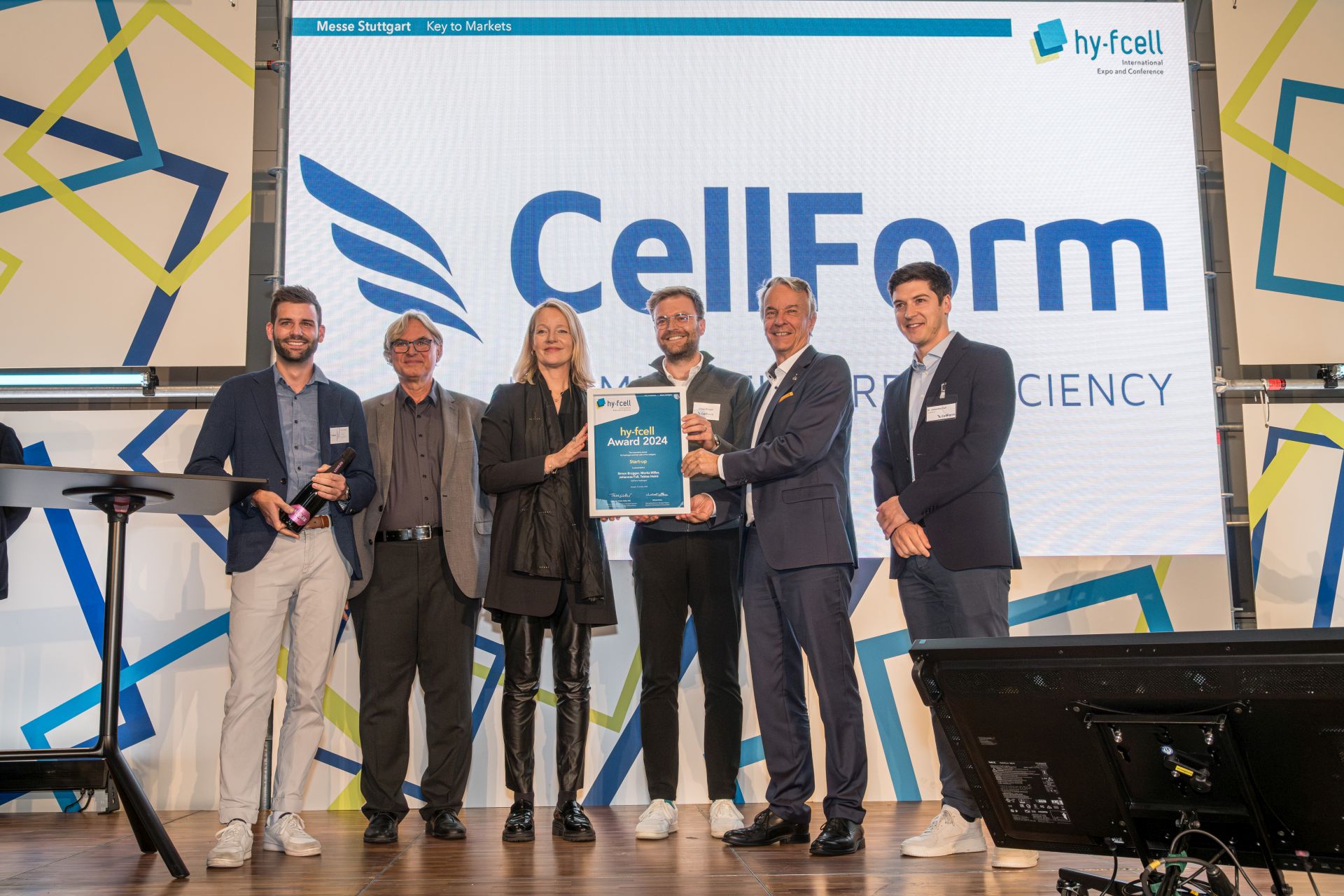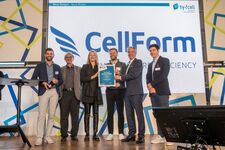Interview with CellForm – winner of the hy-fcell Award 2024
With its revolutionary production technology for bipolar plates, CellForm has made a decisive contribution to increasing efficiency and reducing costs in hydrogen technology. As the winner of the hy-fcell Award 2024 in the "Start-up" category, Cellform is driving forward the industrialisation of this key component and setting new standards for fuel cell and electrolysis applications. In this interview, Simon Brugger, Co-Founder & CEO of CellForm, talks about their pioneering developments, the challenges of being a start-up and their vision for a sustainable hydrogen economy.
Your high-performance bipolar plates reduce the weight of fuel cell vehicles and increase their efficiency at the same time. How exactly does your technology work?
At CellForm, we have developed a forming technology that enables our customers to use significantly thinner materials (currently up to 50µm) while at the same time achieving unique filigree structures on the bipolar plates. These structures place the fuel cell in a performance region in which it can be operated significantly more efficiently and with higher performance.
Your multi-stage forming process and the use of laser welding enable a 50% reduction in sheet thickness - with tangible benefits for the entire fuel cell industry. What distinguishes your solution from previous processes?
We use a multi-stage forming process that achieves to spread the material in the original sheet in exactly the places where the stress to the material leads usually leads to fissures with other forming concepts.
The scalability of hydrogen technology is crucial for the market breakthrough. What role do your bipolar plates play in the cost reduction and widespread introduction of fuel cells?
Bipolar plates play a unique and crucial role in this context. As the plates are installed several hundred times per vehicle and are extremely complex in their construction and needed in high quantities, they are a very unique component which - with the right technology - can "save" thousands of euros per vehicle.
With a cost reduction of 90 % for your bipolar plates, you are making an important contribution to the affordability of fuel cell vehicles. Which markets and applications do you think have the greatest potential for this technology?
Firstly, we need to distinguish between electrolysis and fuel cells in our field. Electrolysis is the foundation of a hydrogen economy. Without sustainable, green and scalable production, the subsequent steps are obsolete. In my opinion, PEM and AEM are here the technologies of the future. Globally, the American region is currently very exciting for us from a technological perspective, as the culture does not treat a young company as neglectfully as German corporations do. At the same time, the market in Asia – today China, in future India – is the most interesting economically.
Your company is the first to successfully form and laser-weld aluminium bipolar plates. What are the advantages of this material for fuel cells?
The use of aluminium leads to weight savings and significantly better heat transfer.
Aluminium is lighter than stainless steel, but has so far been difficult to use for bipolar plates. Why is this innovation a decisive step for the further development of fuel cells and electrolysers?
Aluminium enables an extended application of fuel cells in areas where it is essential to get a lot of heat out of the fuel cell. At the same time, it is a material with good availability and an improvement in the gravimetric efficiency of the stack.
As a start-up in an industry of the future, you face special challenges. What have been your biggest milestones since the company was founded, and what have you learnt from this process?
One of the biggest milestones was the successful development and industrialisation of our multi-stage forming process for bipolar plates with a sheet thickness of up to 50 µm. Another significant step was the successful implementation of our laser welding technology for aluminium bipolar plates, which was previously considered impossible to implement in the industry.
We have learnt that although the market for hydrogen technologies is growing enormously, innovations are only successful if they offer both technical and economic advantages.
Since the foundation of your company, you have already completed numerous international projects with leading fuel cell and electrolysis manufacturers. Has there been a particular challenge or a breakthrough that has decisively advanced your company?
One of the biggest challenges was to seamlessly integrate our ultra-thin bipolar plates into our customers' existing production processes. The switch from conventional manufacturing processes to our high-precision, filigree structures requires far-reaching adjustments along the entire value chain.
A decisive breakthrough was the further development of our forming technology, which enables targeted material distribution. This means that even extremely thin sheets remain mechanically stable, allowing our customers to make their fuel cell systems considerably more powerful and cost-efficient at the same time.
The market entry in Germany was particularly challenging. While we were able to realise projects in North America, the UK and China at an early stage, it took considerably longer before we were able to acquire a German company as a customer. In German industry, there is still a strong reluctance towards start-ups, especially in technology-driven sectors. Innovative strength alone is often not enough here - established companies attach great importance to existing references, company size and a long-standing market presence. These cultural hurdles make it difficult for young companies to assert themselves with new, technologically superior solutions. In other markets, particularly in the USA, we are seeing a much greater openness to innovative approaches and a greater willingness to work with up-and-coming companies.
Winning the hy-fcell Award 2024 has confirmed your innovative strength. How has your company developed since then?
Winning the hy-fcell Award 2024 was an important milestone for us, confirming our technological leadership in the field of bipolar plates. Since then, we have received numerous enquiries from international companies interested in our technology - both from the fuel cell and electrolysis sectors.
Has the award opened up new business opportunities, partnerships or investments for you?
The award has also opened doors to new partnerships, particularly with companies that are active in the scaling of hydrogen technologies. In addition, the increased visibility of our company has also intensified discussions with potential investors.
A look ahead: Where do you see CellForm in five years time, and what new developments are on the horizon?
In five years, we see CellForm as one of the leading suppliers of high-performance bipolar plates for the fuel cell and electrolysis industry. Our aim is to drive forward the industrialisation of our technology and establish scalable series production that will make hydrogen technologies more economical. One focus of our development work is on further reducing production costs in order to promote the widespread use of hydrogen as an energy source. We are also working on new material combinations to further optimise both the gravimetric and volumetric efficiency of fuel cell stacks.
You invest heavily in research and development. Are there any other technological improvements or new applications for your bipolar plates that you are already planning?
Yes, we are constantly working on further technological developments. One of our latest developments is the further optimisation of the thermal conductivity and contact resistance of our bipolar plates, especially for high-performance applications. We are also researching new coating technologies that will further improve the corrosion resistance of our panels and reduce production costs at the same time. Another exciting field of research is the use of hybrid materials that combine the advantages of aluminium and stainless steel in order to unite the best properties of both materials in a bipolar plate. In the long term, we also see potential in the application of our technologies in other industries, such as aviation or stationary energy storage systems.
Interested in the hy-fcell Award 2025? Then apply now: hy-fcell - hy-fcell Award | Messe Stuttgart
zurück zur Übersicht
